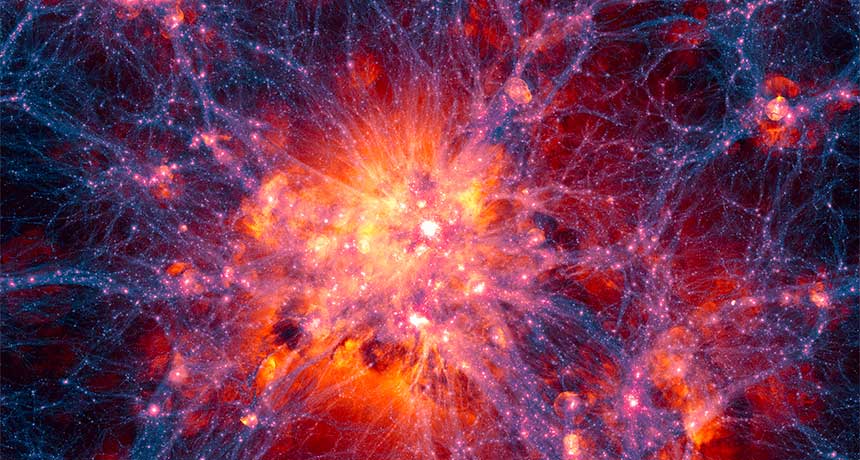
A TANGLED SKEIN This computer simulation of the universe highlights its structure: long filaments of dark matter (blue) with galaxies strung along them like beads (pink). Most of the regular matter is probably stored in gas (orange).
Illustris Collaboration
- More than 2 years ago
Evidence is piling up that much of the universe’s missing matter is lurking along the strands of a vast cosmic web.
A pair of papers report some of the best signs yet of hot gas in the spaces between galaxy clusters, possibly enough to represent the half of all ordinary matter previously unaccounted for. Previous studies have hinted at this missing matter, but a new search technique is helping to fill in the gaps in the cosmic census where other efforts fell short. The papers were published online at arXiv.org on September 15 and September 29.
Two independent teams stacked images of hundreds of thousands of galaxies on top of one another to reveal diffuse filaments of gas connecting pairs of galaxies across millions of light-years. Measuring how the gas distorted the background light of the universe let the researchers determine the mass of ordinary matter, or baryons, that it held — the protons and neutrons that make up atoms.
“It’s a very important problem,” says Dominique Eckert of the Max Planck Institute for Extraterrestrial Physics in Garching, Germany, who has searched for the missing matter via X-rays emitted by individual strands. “If you want to understand how galaxies form and how everything forms within a galaxy, you have to understand the evolution of the baryon content.” That starts with knowing where it is.
About 85 percent of the matter in the universe is mysterious, invisible stuff called dark matter, which physicists have yet to find (SN Online: 9/6/17). Weirdly, about half of the ordinary matter is also unaccounted for. When astronomers look around at the galaxies in the nearest few billion light-years, they find only about half the baryons that should have been produced in the Big Bang.
The rest is probably hiding in long filaments of gas that connect galaxy clusters in a vast cosmic web (SN: 3/8/14, p. 8). Previous attempts to find the baryons focused on X-rays emitted by gas in the filaments (SN Online: 8/4/15) or on the light of distant quasars filtering through these cobwebby strands (SN: 5/13/00, p. 310). But those efforts were either inconclusive, or were sensitive to such a narrow range of gas temperatures that they missed much of the matter.
Now there might be a way to find the rest. Two groups — cosmologist Hideki Tanimura, who did the work while at the University of British Columbia in Vancouver, and his colleagues, and Anna de Graaff of the University of Edinburgh and her colleagues — have sought the missing matter in a new way. Both teams found a way to look through the gas all the way back to the oldest light in the universe.
“Filamentary gas is very difficult to detect, but now we have a technique to detect it,” says Tanimura, now with the Institute of Space Astrophysics in Orsay, France.
That ancient light, called the cosmic microwave background, was emitted 380,000 years after the Big Bang. When this light passes though clouds of electrons in space — such as those found in filaments of hot gas — it gets deflected and distorted in a specific way. The Planck satellite released an all-sky map of these distortions in 2015 (SN: 3/21/15, p. 7).
Tanimura and de Graaff separately figured that there would be more distortion along the filaments than in empty space. To locate the filaments, both teams chose pairs of galaxies from the Sloan Digital Sky Survey catalog that were at least 20 million light-years apart. De Graaff’s team chose roughly a million pairs, and Tanimura’s team chose 262,864 pairs. Both teams assumed that the galaxies were not part of the same cluster, but that they should be connected by a filament.
The filaments were still too faint to see individually, so the teams used software to layer all the images and subtracted out distortion from electrons in the galaxies to see what was left. Both saw a residual distortion in the cosmic microwave background, which they attribute to the filaments.
Next, de Graaff’s team calculated that those filaments account for 30 percent of the total baryon content of the universe. That’s surely an underestimate, since they didn’t examine every filament in the universe, the team writes — the rest of the missing matter is probably there too.
“Both groups here took the obvious first step,” says Michael Shull of the University of Colorado Boulder, who was not involved in the new studies. “I think they’re on the right track.” But he worries that the gas they see might have been ejected from galaxies at high speeds, and so not actually the missing matter at all.
Eckert also worries that the gas may belong more to the galaxies than to their intergalactic tethers. Future observations of the composition of the gas, as well as more sensitive X-ray observations, could help solve that part of the puzzle.







